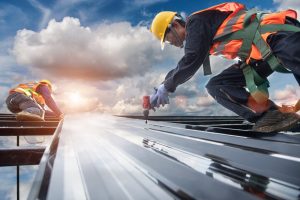Once viewed as purely industrial or agricultural, metal roofing has experienced a renaissance in recent years as a high-end roofing material suitable for modern homes and buildings. Ongoing advances in metal roof technology have led to innovations in coatings, styles, durability, sustainability, and ease of installation that make today’s metal roofs attractive and practical solutions. Key innovations have transformed modern metal roofing into a flexible, efficient, and resilient roofing system poised to become a go-to choice in future construction.
Metal roofs are different from traditional asphalt shingle or tile roofs in several ways. While metal has been used as a roofing material for centuries, recent innovations in metal roofing technology and design have made metal a more popular choice for modern homes and buildings. Some of the key innovations and trends shaping the future of metal roofing include the following:
Advanced Coatings
New types of coating are helping metal roofing resist corrosion, fading, and scratches better than ever before. Kynar and Hylar 5000 coatings use fluoropolymer technology to provide a tough, durable finish. These coatings reflect solar radiation and add brilliance while protecting the metal beneath. Expect continuing advancements in metal coatings that extend roof life.
Improved Style Options
Once only available in corrugated or standing seam designs, metal roofs now imitate luxury slate, tile, cedar shake, or asphalt shingles. Mimicking other roofing materials allows metal to be used in more architectural styles. Stone-coated steel roofing offers an even more luxurious feel, enhancing the curb appeal. More stylish metal roof options will emerge to increase design flexibility.
Greater Longevity
Metal roofing can last 50 years or longer with little maintenance required. The lifespan far exceeds the 15–20 years of asphalt shingle roofing. Factory-formed metal roofing panels and hidden fastener systems eliminate vulnerabilities that could lead to leaks over time. Lifetime warranty options from leading metal roofing manufacturers underscore the exceptional durability offered. Longevity makes metal roofing a cost-effective investment in the long run.

Improved Fire Resistance
Metal roofing is non-combustible and achieves Class A fire ratings, the highest available. The fire resistance gives an important safety advantage over materials like wood shakes. Fire resistance will become increasingly valued as wildfires and urban conflagrations pose growing threats.
Hail/Impact Resistance
Hail and falling debris can rapidly damage many roofing types. Metal roofing holds up better under such impacts. Standing seam metal roofing, in particular, resists puncture or tear-through from hail storms or hurricane winds launching projectiles. Impact testing continues to make metal roofing suitable for regions with extreme weather.
Solar Integration
Metal roofing can integrate solar panels through standing seam mounting systems. The elevated profile creates airflow to improve solar efficiency. Clean lines and lack of roof penetrations maintain weather tightness. Solar coordination will become standard as more buildings add photovoltaic generation.
Rainwater Capture Integration
Metal roofing repels chemicals or particulates that could contaminate rainwater runoff. The sloped sheets efficiently direct rain into collection systems. Integration with rainwater harvesting expands in communities, promoting sustainable water and building strategies.
Energy Efficiency
Reflective metal roofing helps reduce cooling loads in warm climates. Adding a radiant barrier during installation further blocks heat gain. The U-factor of insulated metal roof assemblies measures up to 50% better than tile. Enhanced energy efficiency lowers lifetime utility costs.
Reduced Weight
Metal roofing weighs less than tile, slate, or concrete products. The lighter mass reduces stress on roof framing. Metal roofing retrofits become easier by avoiding overloading issues, especially for large commercial buildings. More lightweight roofing also benefits wind and seismic resilience. Transportation and installation processes are simplified, leading to potential cost savings and increased efficiency in construction projects.
Simplified Installation
Metal roofing comes in large panels or shingles that reduce rooftop labor. Standing seam roofing goes up quickly with concealed fasteners. Less time on the roof means lower overall job costs. Faster installation also implies fewer weather delays compared to multistep roofing materials.
Recyclability
Metal roofing contains up to 70% recycled content from the steelmaking process. At the end of its service life, metal roofing can return to furnaces as recycled feedstock. The full life cycle represents sustainable materials management with minimal waste. Closed-loop recyclability will grow more relevant as environmental consciousness increases.
The Future Outlook
The future of metal roofing promises even more significant technological advancements, sustainability, and design advancements. As climate change continues to impact global weather patterns, the demand for resilient and energy-efficient building materials will only grow. Metal roofing, with its proven track record of durability and sustainability, is poised to play a significant role in addressing these challenges and shaping the construction industry’s future.
Final Thoughts
Innovations in metal roofing point to it becoming an increasingly popular, cost-effective, and practical roofing choice. The combination of aesthetics, durability, safety, sustainability, efficiency, and ease of installation offered by modern metal roofing positions it as an ideal roofing solution for the future. Continued advances in metal coatings, styles, solar integration, water management, and recycled content will solidify metal as a go-to roofing material for years.

